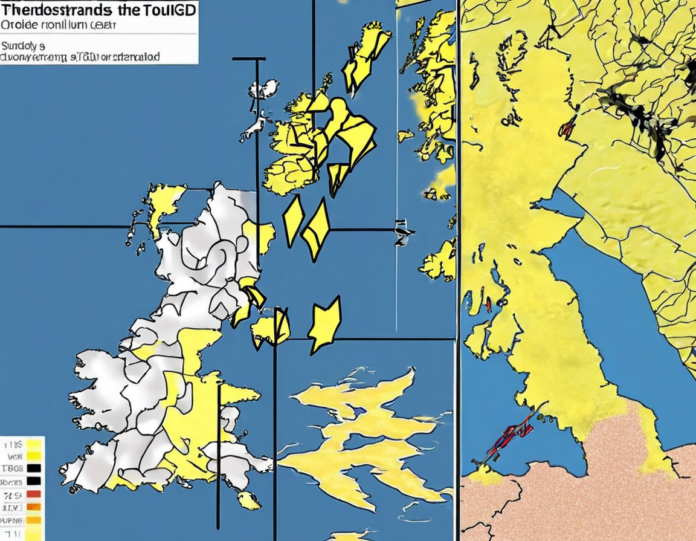The UK Meteorological Office has issued a yellow warning for thunderstorms across different regions of the United Kingdom on Sunday. According to the weather forecast, the onset of thundery showers may bring risks of lightning strikes, hail, and heavy rainfall leading to potential flash floods in some areas. Such weather conditions can pose hazards to public safety and have implications for transportation, outdoor activities, and property damages.
Understanding Thunderstorms
Thunderstorms are intense weather phenomena characterized by the presence of thunder and lightning, often accompanied by heavy rain and strong winds. These storms develop within a convective system where warm, moist air rises rapidly, creating instability in the atmosphere. The rising air cools and condenses, forming cumulonimbus clouds that can reach great heights. Within these clouds, the interactions between ice particles and water droplets generate electrical charges, resulting in lightning.
Impact of Thunderstorms
-
Lightning Strikes: Lightning is a significant risk during thunderstorms. When lightning strikes the ground or buildings, it can pose a serious danger to individuals. It is essential to seek shelter indoors during thunderstorms to avoid the risk of being struck by lightning.
-
Hail: Thunderstorms can also produce hail, which are balls of ice that form within the intense updrafts of the storm. Hailstones can vary in size from small pellets to larger, damaging pieces that can harm property and crops.
-
Heavy Rainfall: Thunderstorms often bring intense rainfall within a short period, leading to localized flooding. Flash floods can occur in low-lying areas or regions with poor drainage systems, causing disruptions to transportation and posing risks to life and property.
-
Strong Winds: Thunderstorms can generate strong, gusty winds that may cause damage to structures, trees, and power lines. Flying debris propelled by high winds can pose hazards to individuals and vehicles outdoors.
Safety Precautions During Thunderstorms
-
Stay Indoors: Seek shelter indoors during thunderstorms to avoid the risk of lightning strikes. Stay away from windows, doors, and electrical appliances to prevent potential harm.
-
Avoid Water Bodies: Refrain from swimming or boating during thunderstorms as water is an excellent conductor of electricity. Move to safer locations away from water bodies.
-
Secure Outdoor Items: Tie down or bring inside any outdoor furniture, equipment, or items that could be carried away or damaged by strong winds or hail.
-
Monitor Weather Updates: Stay informed about local weather forecasts and warnings issued by meteorological agencies to prepare for impending thunderstorms and take necessary precautions.
-
Emergency Kit: Prepare an emergency kit with essential supplies such as food, water, medications, flashlights, and batteries in case of power outages or disruptions caused by thunderstorms.
Frequently Asked Questions (FAQs)
- What is the difference between a thunderstorm watch and a warning?
-
A thunderstorm watch indicates that conditions are conducive to the development of thunderstorms in a particular area, while a warning means that thunderstorms are imminent or occurring.
-
How can I protect my electronic devices during a thunderstorm?
-
Unplug electronic devices and appliances to protect them from power surges caused by lightning strikes.
-
Is it safe to use my landline phone during a thunderstorm?
-
It is advisable to avoid using landline phones during thunderstorms, as lightning can travel through phone lines, posing a risk of electric shock.
-
What should I do if I am caught outside during a thunderstorm?
-
Seek shelter in a sturdy building or a hard-topped vehicle to avoid exposure to lightning and other hazards. Avoid open fields, tall trees, and metal objects.
-
How common are thunderstorms in the UK?
-
Thunderstorms are relatively common in the UK, particularly during the spring and summer months when warm, moist air masses interact with cooler air, creating instability in the atmosphere.
-
Can thunderstorms lead to power outages?
-
Yes, thunderstorms with strong winds and lightning strikes can cause power outages by damaging electrical infrastructure such as power lines and transformers.
-
Are there any long-term effects of frequent thunderstorms on the environment?
-
Thunderstorms play a role in the natural balance of the environment by contributing to rainfall and atmospheric cleansing. However, severe storms can cause short-term damage to ecosystems and infrastructure.
-
What are some signs that a thunderstorm is approaching?
-
Signs of an approaching thunderstorm include darkening skies, distant rumbling thunder, gusty winds, and an increase in humidity.
-
Can thunderstorms trigger asthma attacks or exacerbate respiratory conditions?
-
Some individuals with asthma or respiratory conditions may experience worsened symptoms during thunderstorms due to changes in air pressure, pollen dispersal, and air pollutants.
-
How can I help others during a thunderstorm emergency?
- Check on neighbors, particularly the elderly or vulnerable individuals, to ensure they are aware of the weather situation and have necessary provisions to stay safe during the storm.




